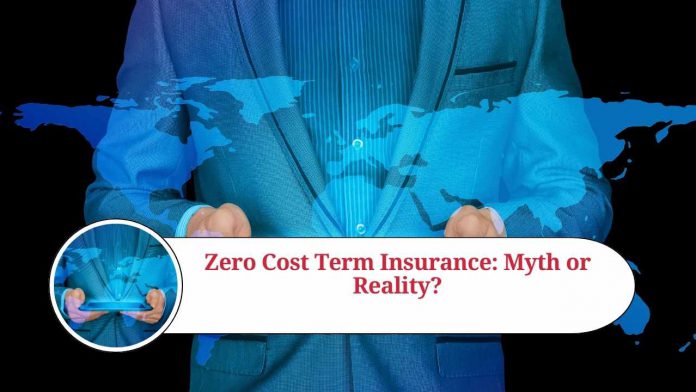Zero Cost Term Insurance
When it comes to financial planning and securing the future of our loved ones, life insurance plays a crucial role. Term insurance, in particular, offers a simple and affordable way to provide financial protection in the event of an untimely demise. But what if you came across an enticing offer for a zero-cost term insurance policy? Is it too good to be true? In this blog, we will explore the concept of zero-cost term insurance and shed light on whether it is a myth or a reality.
Understanding Term Insurance: Before delving into the concept of zero-cost term insurance, let’s have a brief overview of term insurance itself. Term insurance is a type of life insurance that provides coverage for a specific period, known as the term. If the policyholder passes away during the term, the designated beneficiaries receive a death benefit payout. Unlike other types of life insurance, term insurance does not have a cash value component and is solely focused on providing protection.
What is Zero Cost Term Insurance?
Zero-cost term insurance, as the name suggests, refers to a term insurance policy that allegedly comes with no premium payment. This concept may sound appealing and too good to pass up, but it’s essential to understand the underlying mechanisms behind such offers.
The Reality of Zero-Cost Term Insurance: In reality, zero-cost term insurance is more of a marketing gimmick rather than an actual product. While it’s true that some insurance companies may offer a waiver of premium rider, which waives the premium payments in the event of disability or critical illness, a truly “zero cost” policy does not exist. Insurance companies are businesses, and they require funds to cover administrative expenses, claims payouts, and generate profits. Therefore, they must charge premiums to sustain their operations.
Unveiling the Hidden Costs: Although the premium payment might be waived in certain circumstances, the cost of the insurance coverage is still factored into the policy. Insurance companies consider various factors such as age, health, occupation, and lifestyle when determining the premium amount. The premium is calculated to ensure that the company can cover the risks associated with the insured individual. Thus, even if the premium payment is temporarily waived, it does not mean that the insurance coverage is entirely free.
The Importance of Transparency: It’s crucial to be wary of insurance policies that claim to offer zero-cost term insurance without providing clear explanations of how they can sustain such offers. Legitimate insurance providers emphasize transparency and clearly outline the premium structure and associated costs. Always read the policy documents carefully and ask questions to ensure you understand the terms and conditions.
Alternative Strategies to Reduce Premiums: While a truly zero-cost term insurance policy may not exist, there are strategies you can employ to reduce the premiums for your term insurance coverage:
- Compare Quotes: Shop around and obtain quotes from different insurance providers. This allows you to compare premiums and find the most cost-effective option.
- Healthy Lifestyle: Maintaining a healthy lifestyle can positively impact your premium rates. Non-smokers, individuals with a healthy weight, and those with no pre-existing medical conditions often receive lower premiums.
- Term Length: Opting for a shorter term length can result in lower premiums. Evaluate your financial goals and select a term that aligns with your needs.
- Regular Reviews: Periodically review your insurance coverage to ensure it aligns with your current needs. As you age, you may require less coverage, which can reduce the premiums.
Conclusion
While zero-cost term insurance policies may seem enticing, it’s crucial to understand that they are mostly marketing tactics. Genuine-term insurance coverage involves premium payments to sustain the financial viability of the insurance company. However, by employing various strategies, you can still reduce your premium costs and secure affordable coverage. Remember to choose a reputable insurance provider,
Read more useful content:
Frequently Ask Question
Q: What is zero-cost term insurance?
A: Zero-cost term insurance refers to a term insurance policy that claims to have no premium payments. It implies that the policyholder can obtain life insurance coverage without any financial obligations.
Q: Is zero-cost term insurance a reality?
A: No, zero-cost term insurance is not a reality. While some insurance companies may offer premium waiver riders in certain circumstances, there are still costs associated with the coverage. Insurance companies require funds to cover administrative expenses, claims payouts, and generate profits, which necessitate the collection of premiums.
Q: How do insurance companies sustain zero-cost term insurance claims?
A: Insurance companies cannot sustain zero-cost term insurance claims. Even if the premium payment is temporarily waived, the costs of providing coverage are still factored into the policy. Insurance companies consider various factors and calculate premiums to cover the risks associated with insuring an individual.
Q: Are there any hidden costs associated with zero-cost term insurance?
A: Yes, there may be hidden costs associated with zero-cost term insurance. While the premium payment might be waived in certain situations, the actual cost of the coverage is included in the policy structure. Insurance companies consider this cost to ensure they can cover the risks and maintain their financial stability.
Q: How can I reduce the premiums for my term insurance coverage?
A: While zero-cost term insurance may not be feasible, there are strategies to reduce premiums:
- Compare quotes from different insurance providers to find the most cost-effective option.
- Maintain a healthy lifestyle, as non-smokers and individuals with no pre-existing medical conditions often receive lower premiums.
- Opt for a shorter term length, as it can result in lower premiums.
- Regularly review your insurance coverage to ensure it aligns with your current needs, adjusting the coverage amount as necessary.
Q: What should I look for when considering a term insurance policy?
A: When considering a term insurance policy, it’s important to look for transparency in terms of premium structure and associated costs. Read the policy documents carefully, ask questions, and ensure you understand the terms and conditions before making a decision. Choose a reputable insurance provider that emphasizes transparency and provides clear explanations of the premium calculation process.
Q: Can I trust insurance providers that claim to offer zero-cost term insurance?
A: It’s important to exercise caution when dealing with insurance providers that claim to offer zero-cost term insurance. Legitimate insurance providers emphasize transparency and clearly outline the premium structure and associated costs. Be wary of any claims that seem too good to be true and always do thorough research before committing to a policy.




















